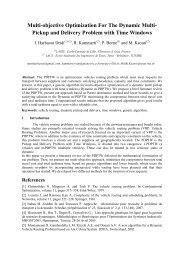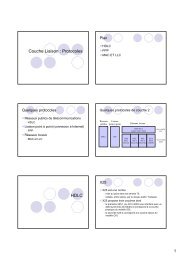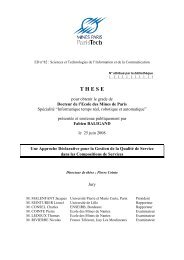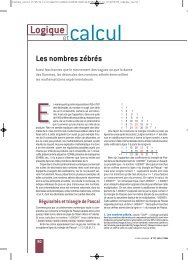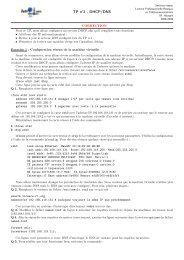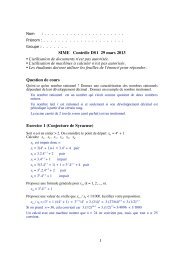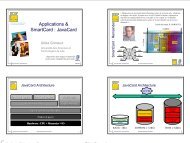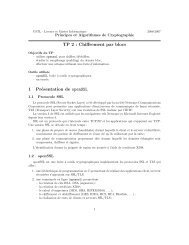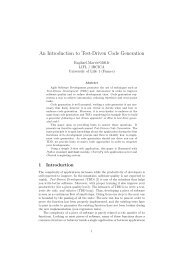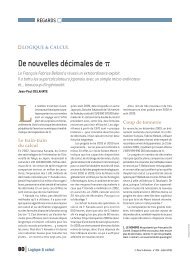Optimal Configuration of OLSR Routing Protocol for VANETs by ...
Optimal Configuration of OLSR Routing Protocol for VANETs by ...
Optimal Configuration of OLSR Routing Protocol for VANETs by ...
Create successful ePaper yourself
Turn your PDF publications into a flip-book with our unique Google optimized e-Paper software.
2 J. Toutouh, J. García-Nieto and E. Alba<br />
In order to evaluate the per<strong>for</strong>mance <strong>of</strong> the different <strong>OLSR</strong> configurations (DE solutions),<br />
we have measured the resulted QoS indicators <strong>of</strong> the network <strong>by</strong> means <strong>of</strong> three commonly used<br />
metrics in this area: Packet Delivery Ratio (PDR), Normalized <strong>Routing</strong> Load (NRL), and Average<br />
End-to-End Delay (E2ED) <strong>of</strong> a data packet. These metrics are returned <strong>by</strong> ns-2 after simulating a<br />
VANET scenario consisting in a urban area <strong>of</strong> 4Km 2 from downtown <strong>of</strong> the Spanish city <strong>of</strong> Málaga<br />
(taking into account road directions, signal lights, and traffic rules). In this VANET scenario, 50<br />
vehicles exchange in<strong>for</strong>mation with each other during 300 seconds. After each simulation, ns-2<br />
returns the three QoS indicators and this in<strong>for</strong>mation is used to compute the fitness function:<br />
fitness = w 1 · (−P DR) + w 2 · NRL + w 3 · E2ED · C (1)<br />
The objective here consists in maximizing PDR, and minimizing both, NRL and E2ED. As<br />
expressed in Equation 1, we used an aggregative minimizing function, and <strong>for</strong> this reason PDR<br />
was <strong>for</strong>mulated with a negative sign. Factors w 1 , w 2 , and w 3 (0.8, 0.1, and 0.1, respectively)<br />
were empirically assessed <strong>for</strong> weighing the influence <strong>of</strong> each metric on the fitness value. Constant<br />
C = 0.01 set the E2ED with the same range to PDR and NRL factors.<br />
3 Results<br />
The main results obtained after experimentations are presented in Table 2. They consist on: results<br />
obtained <strong>by</strong> three configurations (#1, #2 and #3) reported <strong>by</strong> experts Gómez [4], results <strong>of</strong><br />
using the default parameters from RFC 3626 configuration, and results <strong>of</strong> the best configuration<br />
optimized <strong>by</strong> our DE (average best out <strong>of</strong> 30 independent runs with the Málaga city scenario).<br />
Table 2. <strong>OLSR</strong> configurations obtained <strong>by</strong> DE, RFC 3626 definition, and experts (Gómez et al. [4])<br />
<strong>Configuration</strong> Fitness PDR NRL E2ED<br />
#1 46.19 90.00% 1170.02 kbps 1197.25 ms<br />
Gómez [4] #2 -15.31 90.00% 554.75 kbps 1208.91 ms<br />
#3 -29.47 66.00% 208.84 kbps 2435.22 ms<br />
RFC 3626 61.22 80.00% 328.42 kbps 1347.22 ms<br />
DE Best -68.35 94.00% 68.34 kbps 8.36 ms<br />
As we can observe, the <strong>OLSR</strong> configuration optimized <strong>by</strong> DE shows the best per<strong>for</strong>mance in<br />
terms <strong>of</strong> both, the fitness value and the QoS indicators. We can notice that DE configuration<br />
obtained better PDR than standard RFC and Gómez et al. [4] configurations (PDR <strong>of</strong> 90% in #1<br />
and #2, 80% in RFC, and 94% in DE).<br />
However, it is in the network load (NRL) and in the average delay (E2ED) where optimized<br />
configurations <strong>by</strong> DE reached the highest improvement, being a reduction <strong>of</strong> 67.28% (from 328.42<br />
kbps to 68.34 kbps) concerning NRL and 99.66% (from 1347.22 ms to 8.36 ms) in E2ED over #3,<br />
the best configuration in terms <strong>of</strong> fitness <strong>of</strong> Gómez et al. [4].<br />
In the light <strong>of</strong> these preliminary results, we can conclude that our approach is able to outper<strong>for</strong>m<br />
the standard <strong>OLSR</strong> configuration and even parameters set <strong>by</strong> human experts in this matter. In<br />
this sense, we will explore the use <strong>of</strong> our optimization model in the configuration <strong>of</strong> the <strong>OLSR</strong><br />
protocol <strong>for</strong> other VANET scenarios in future experiments.<br />
Acknowledgements Authors acknowledge funds from the CICE, J. Andalucía, contract P07-TIC-03044<br />
(DIRICOM http://diricom.lcc.uma.es) and Spanish Ministry MICINN and FEDER contract TIN2008-<br />
06491-C04-01 (M* http://mstar.lcc.uma.es). José García-Nieto is supported <strong>by</strong> grant BES-2009-018767<br />
from the MICINN<br />
References<br />
1. The Network Simulator Project - Ns-2. [online] http://www.isi.edu/nsnam/ns/.<br />
2. T. Clausen and P. Jacquet. Optimized Link State <strong>Routing</strong> <strong>Protocol</strong> (<strong>OLSR</strong>). IETF RFC 3626, 2003<br />
[online] in URL http://www.ietf.org/rfc/rfc3626.txt.<br />
3. J. Garca-Nieto, J. Toutouh, and E. Alba. Automatic tuning <strong>of</strong> communication protocols <strong>for</strong> vehicular<br />
ad hoc networks using metaheuristics. Engineering Applications <strong>of</strong> AI, 23(5):795 – 805, 2010.<br />
4. C. Gómez, D. García, and J. Paradells. Improving per<strong>for</strong>mance <strong>of</strong> a real ad hoc network <strong>by</strong> tuning olsr<br />
parameters. In ISCC ’05, pages 16–21, Washington, DC, USA, 2005. IEEE Computer Society.<br />
5. J. Santa, M. Tsukada, T. Ernst, O. Mehani, S. Gómez, and F. Antonio. Assessment <strong>of</strong> VANET multi-hop<br />
routing over an experimental plat<strong>for</strong>m. Int. J. Internet Protoc. Technol., 4(3):158–172, 2009.



